Where in the World is Dr. Salus "Dynamica" Mundi?
(A Global Public Health Game)
Where in the World is Dr. Salus "Dynamica" Mundi?
Mr. Newsian "Tasks" You...
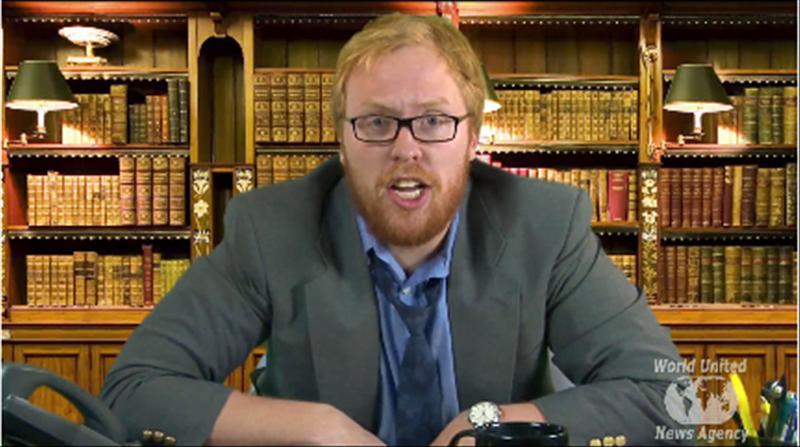
(Zachary J. Caby as Mr. Newsian, of the World United News Agency)
Directions: Please click on the above image to acquire the message from Mr. Newsian...to start the game.
Game Instructions
The World United News Agency has sent their ace reporter Nina Novus to find world-renowned global health expert Dr. Salus "Dynamica" Mundi so as to do an exclusive video interview. Your mission is to help reporter Nina Novus by going through the info reading and watch her news updates. After figuring out the clues provided, you must help Nina Novus navigate the world to find out Where in the World Dr. Salus "Dynamica" Mundi could be.
|
Game Section Introduction
The higher education game created for global health is called "Where in the World is Dr. Salus 'Dynamica' Mundi?" It was created by the Information Technology Assistance Center (iTAC) and Office of Mediated Education (OME) at Kansas State University in coordination with Dr. Deborah J. Briggs. This was created in mid-to-late 2011 for the purposes of providing a fun and engaging way for people to learn about various aspects of global health. This game is provided below for you to interact with and experience so as to gain further insights into the realm of global health in a more personable way than purely through lecture/reading.
After the game, this article will describe in greater detail the thought process that went into the game's development (game creation and workflow), and presentation (media selection, production, interactivity, and assessment).
-- Brent A. Anders
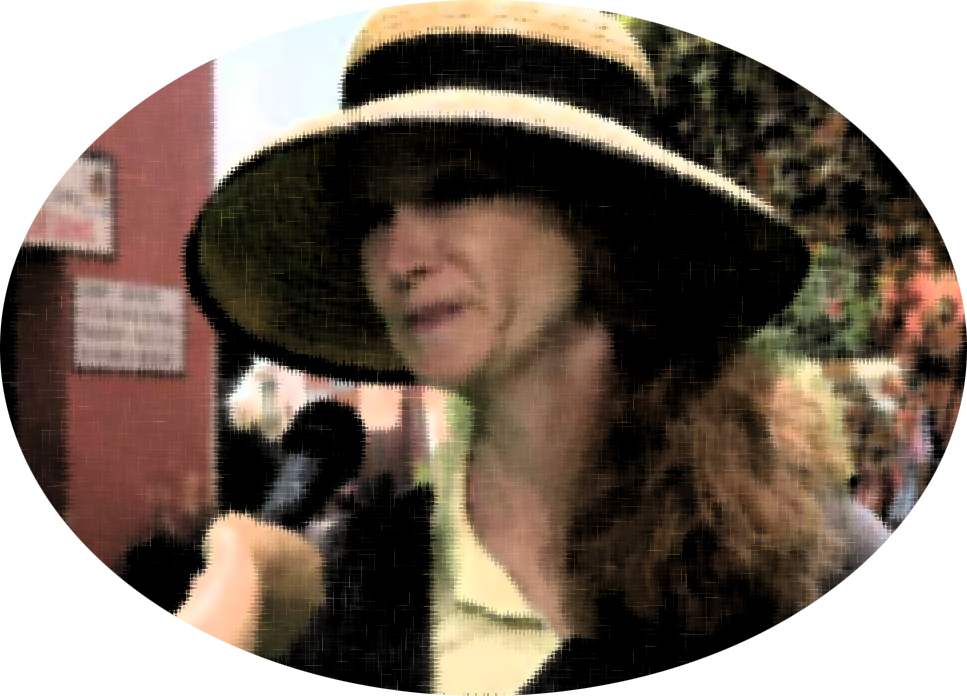
Where in the World is Dr. Salus "Dynamica" Mundi?
The International: The First Sighting
Nina Novus first becomes aware of Dr. Salus "Dynamica" Mundi (Dr. Global "Dynamic" Health) when she publishes a work on international conferences, and Novus becomes aware that she could be on to the scoop-of-her-career...
|
A RESEARCH ARTICLE
The Importance of International Conferences for Global Health
By Dr. Salus "Dynamica" Mundi
Why should we have international conferences for global health and why should attending these conferences be an important priority for a professional in the global health field? The answer is in the question; it is the professional thing to do. Professionals belong to professional organizations, are continually learning and are seeking new ways to improve the state of global health.
The benefits of attending international conferences are many, with long lasting and powerful effects:
Education
Many of these conferences are not only informational presentations but also incorporate workshops on how to accomplish or use new systems, techniques, or technologies. Simply hearing a presentation on how one practitioner solved a global health issue in one part of the world could cause attendees to see different approaches of handling a similar situation in their part of the world. New answers (as well as problems) are constantly emerging throughout the world. As professionals it is important to continually learn so as to stay abreast of situations around the world. Very few global health issues remain isolated in that the world is much smaller place due to ever changing politics, improved transportation, and globalization of trade.
Networking and Partnerships
A long lasting and far-reaching effect of international conferences is that of being able to network and establish partnerships. The excitement and energy of a gathering of like-minded professionals, all passionate about global health, naturally leads to enhanced communications and interactions. Being able to make contacts all over the world can be a priceless asset when conducting research or seeking guidance dealing with situations that have already occurred in other parts of the world. Being able to partner with other professionals on projects can also vastly cut costs (or provide funding itself) as well as save time and provide large benefits from having multiple points of view so as to enhance the overall approach. The friendships, camaraderie, and bonds are also very empowering and often give professionals a new zeal and drive to maximize their efforts and improving global health.
World View
Some professionals get so focused on their particular expertise that they lose sight of the larger picture of global health. I forget that many events and situations have a domino effect that starts in one small village and travels around the world through billions of people and comes back to the starting point. We are all connected and sometimes attending an international conference helps to remind everyone how we are all interconnected. Presenting ones findings as well as hearing others views and their finding helps to broaden everyone's understanding and world view.
Professional Opportunity
The only way to improve ones presentation skills is to present. International conferences offer a perfect venue for presenting one's latest research, starting a discussion on a particular situation or concern, or countering a proposed approach on a global health issue. Additionally making a presence at these international conference aids in one's own "branding" and recognition. People start to notice those professionals who attend and present and are making an impact on global health.
Cultural Exchange
Exposure to people from all over the world and multiple cultures greatly enhances our professional understanding of global health dynamics. Understanding the differences in languages, cultural norms, religious practices, political structures, mannerisms, and general beliefs, can have vast implications and could determine how well a global health program does in a particular part of the world. Learning about these differences among us via text and video is one thing, but actually being able to interact with someone from that country/culture is a much greater and salient experience. Seemingly small details such as how to properly greet someone, what clothing to wear, interactions between men and women and so on can in fact have a huge impacts on ones ability to get things done and be successful with global health missions in different countries/cultures.
Although attending international conferences on global health does require financing and time allocation, the benefits vastly outweigh the costs. It is strongly recommending that all professionals in the global health field make to time attend, learn, contribute and benefit to all that these international conferences have to offer.
Some Resources
Resources dealing with international conference on global health can be found at:
Global Health Education Consortium: Global Health Conference
Held in a different part of the world every year, example: Czech Republic, Canada, Dominican Republic, etc.: www.globalhealtheducation.org/events/Pages/default.aspx
Global Health Council: International Conference
Held in Washington D.C.: USA
www.globalhealth.org/conference_2011
Conference on Global Health and Vaccination Research and the Norwegian Medical Association`s Conference (Den Norske Legeforening)
Held in Oslo, Norway
http://www.legeforeningen.no/id/167967.0
Unite for Site: Global Health and Innovation Conference
Held in Yale University, Connecticut: USA
www.uniteforsight.org/conference
Royal Society for Public Health International Conference
Held in London, UK
http://www.rsph.org.uk/en/courses-conferences-and-events/public-health-international-conference/index.cfm
|
Nina Novus catches her viewers up with her ambitions for catching up with Dr. Mundi for an exclusive interview.

Directions: Play only one of the following videos to the location that you've identified.
The Dominican Republic

Egypt

India

Mexico

Russia


Where in the World is Dr. Salus "Dynamica" Mundi?
Pharmaceutical Success
Nina Novus has been following Dr. Salus Mundi on her Facebook™ account. If anything, she is appreciative of the access, but she's also getting the sense that Dr. Mundi is focused almost exclusively on her work.
|
AN INFORMATIVE HANDOUT
International Pharmaceutical Companies and their Impact on Vaccinating the Needy
By Dr. Salus "Dynamica" Mundi
Getting excess shipments of medications and supplies to various places in the world where those supplies are desperately needed is often done in the background and quietly by "big pharma" (international pharmaceutical companies). One of the lesser-known aspects of "big pharma" companies is that they contribute much to the world's global public health—even when the profit motive is less defined.
PROCESS
In order to fully understand how International Pharmaceutical companies help in an effort to vaccinate the world from potentially deadly viruses, we first need to know how a vaccine is made. The attached image (Vaccine Development) shows how a vaccine is developed. Vaccines often use a weakened form of the virus that it is combating to trigger a health response in the human body, so that if the person is exposed to the actual virus on a future date, the body will muster a rigorous defense and shut down the invading virus from multiplying and causing disease. Vaccines may be designed for viral or bacterial pathogens.
The process of creating vaccine can cost well over $100 million dollars to develop, test, and develop clinical trials. The costs of creating vaccines are also high because of the complex levels of scientific research and painstaking production that goes into the work to make the vaccines effective and hygienic for mass use.
DELIVERY
There is an art and logistics to getting vaccines to people. There are optimized ways of delivering the vaccine with the proper level of potency. For children, vaccine makers strive to deliver the medicine through oral means to lower the potential fear factor. Public health officials often accompany mass vaccination opportunities with plenty of outreaches and educational endeavors.
While there are many needs for health-giving drugs in developing countries, the economies in those various countries are often not sufficient to sustain the purchases of the cutting-edge medications. Many times, such countries purchase generics after the patents have gone into the public realm. Other times, they purchase knock-offs with uncertain formulas and uncertain side-effects.
BENEFIT
Thankfully many prominent "big pharma" companies such as those in the United States, United Kingdom, Japan, Germany, and Switzerland, give away vaccines in needy areas of the world instead of letting a vaccine "date out" (exceed its shelf life; often happens due to an over-production schedule). Although "big pharma" companies are indeed a business and are "in it" to make money, giving away these much needed vaccines provides these companies some tax write-off for their charitable donation and some positive publicity for their actions. The system isn't perfect of course, but in this way at least, international pharmaceutical companies are having a big positive impact on vaccinating the needy people of this world.
|
Even though Novus prefers her informational contents fresh and raw, Nina Novus is not beyond reading the mainline press to get her information. She has just come across a news feed from Reuters that Dr. Salus "Dynamica" Mundi has been working with an international pharmaceutical company to get excess shipments of medications and supplies to various places in the world where those supplies may be needed. This work is often done on background and quietly. One of the lesser known aspects of "big pharma" companies is that they do contribute much to the world's global public health—even when the profit motive is less defined. At the end of one of the articles, the reporter says that a representative for Dr. Mundi says that she will be traveling with a vaccine shipment to aid in the distribution in a developing country.
Nina brings out her mobile device and reviews her notes. She peruses an informational diagram about the process of making an influenza vaccine.
|
NINA NOVUS' ELECTRONIC NOTEBOOK
Vaccines often use a weakened form of the virus that it is combating to trigger a health response in the human body, so that if the person is exposed to the actual virus on a future date, the body will muster a rigorous defense and shut down the invading virus from multiplying and causing disease. Vaccines may be designed for viral or bacterial pathogens.
The costs of creating vaccines are high because of the complex levels of scientific research and painstaking production that goes into the work to make the vaccines effective and hygienic for mass use.

(The above open-source image was created by the National Institute of Allergy and Infectious Diseases of the US Department of Health and Human Services / National Institutes of Health. This image is in the public domain)
There is an art and logistics to getting vaccines to people. There are optimized ways of delivering the vaccine with the proper level of potency. For children, vaccine makers strive to deliver the medicine through oral means to lower the potential fear factor. Public health officials often accompany mass vaccination opportunities with plenty of outreaches and educational endeavors.
|
First, though, Dr. Mundi would be going to the pharmaceutical company in order to take part in a hand-shaking ceremony and to stand next to boxes of the vaccine.
If the company was going to be giving away vaccine that was dating out within the year because of an over-production schedule, they wanted not only to have a tax write-off for their charitable donation but also to be able to gain some positive publicity for it. The pharmaceutical company already had its media channels set up and had notified all those whom they were going to invite. If Nina was going to crash the event, she would have to figure out which one of the companies was hosting this.
Novus looks more closely at the stash of electronic articles she has on Dr. Mundi. She finds that the good doctor has worked with a half-dozen such companies in the past decade. If she were to guess, people tend to cultivate relationships, and if they're constructive, people tend to continue those relationships.
While there are many needs for health-giving drugs in developing countries, the economies in those various countries are often not sufficient to sustain the purchases of the cutting-edge medications. Many times, such countries purchase generics after the patents have gone into the public realm. Other times, they purchase knock-offs with uncertain formulas and uncertain side-effects.
She makes a table of the pharmaceutical companies with their drug areas of specialty. She is hoping to use a process of elimination to figure out which pharmaceutical company in which country she will head to. She simplifies down the information she has.
From press accounts, she knows the following facts to be true:
- The vaccine is for the current year's flu profile.
- The donated shipment involves sufficient amounts of vaccines for over ten thousand people—with specialized dosages for adults and others for children.
- The company is not a domestic one.
|
Pharma 1 (USA)
|
This boutique pharmaceutical company specializes in drugs dealing with attention deficit hyperactivity disorder (ADHD), in both adults and children.
|
|
Pharma 2 (United Kingdom)
|
This company deals with vaccines against certain tropical diseases like Yellow fever, dengue fever, encephalitis, Chikungunya, West Nile, and Rocky Mountain Spotted Fever.
|
|
Pharma 3 (Japan)
|
This company creates prophylactics for the treatment of insect vector-borne diseases like malaria, filariasis, and West Nile.
|
|
Pharma 4 (Germany)
|
This company is a specialty company that deals with drugs for oncology-based needs.
|
|
Pharma 5 (Switzerland)
|
This company provides both over-the-counter and prescription-based vaccines for mass consumption.
|
Novus's press pass has sometimes worked magic in getting her access to people who would not talk to her otherwise. She has confidence that if she shows up at the event that she would not be turned away and that Dr. Mundi might find the time to give her a world exclusive. Nina studies the map.
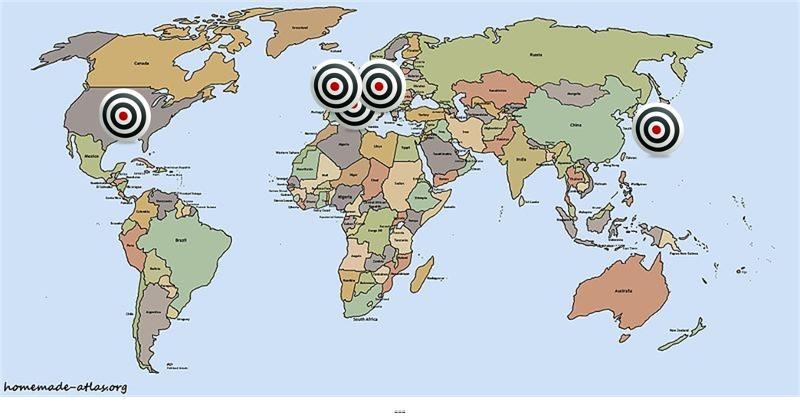
Novus catches her viewers up with her ambitions for catching up with Dr. Mundi for an exclusive interview.

She has found a clue in the following Facebook™ video.

Directions: Play only one of the following videos to the location that you've identified.
Germany

Switzerland

Japan

United Kingdom (UK)

United States

She writes down a few more questions that she has brainstormed for Dr. Mundi. She takes the next flight out, chaining together destinations in a computerized mess that gets her closer, she hopes.

Where in the World is Dr. Salus "Dynamica" Mundi?
The Clean Water Village
Mobile Global: The Online Global Health Magazine for Professionals
TITLE: "Clean Water and Improved Living for Rural Villagers"
AUTHOR: Dr. Salus "Dynamica" Mundi
For people who live out in the rural villages of the world, with a little less than half of the world's people living in rural areas, they need access to clean water. They need ways to irrigate their crops. They need hardy seeds, fertilizer, pesticide solutions, and insights about what efforts they should take for every phase of farming: preparing the fields, planting seeds, shaping the landscape, irrigation, fertilizing, and harvesting. In the long-term, they have to protect their fields from topsoil loss and from mis-use—which might lead to the inability to raise crops, or worse, erosion and desertification.
Various volunteer public health projects deal with improving the livelihoods of people who live in rural areas. Engineering students support the building of various structures to increase the quality of life in villages—such as the building of water wells. Some of these endeavors involve training the locals to use hand soap so as to protect against a variety of fomite-transferred diseases. Others train locals in raising food animals in effective ways and ensuring procedures to keep drinking water clean and accessible.
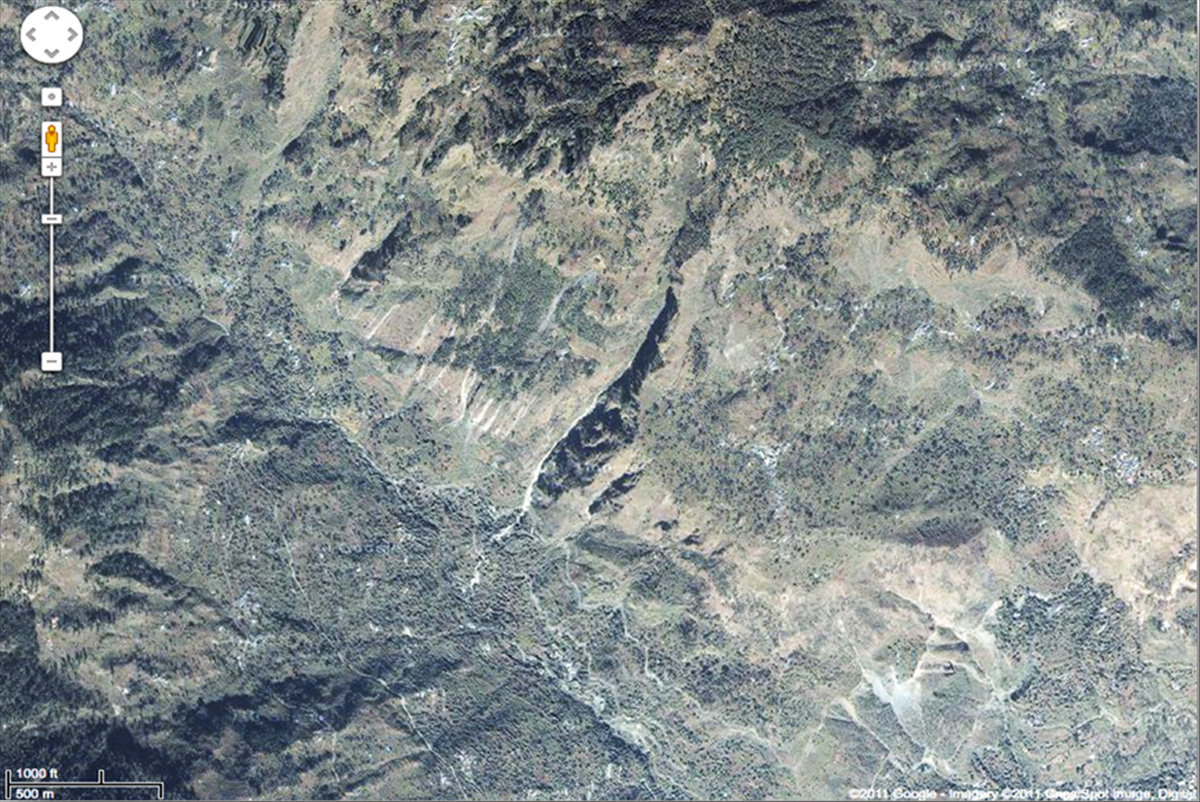
People in the villages also need access to healthcare. Sometimes, this comes in the form of mobile vehicles that drive out to various locations to offer limited services—like inoculations or dental services. Those who have more serious health needs have to go into the larger cities where the college-trained medical care personnel have their clinics. Often, villages are far from larger cities and are located in harder-to-reach rural areas.
People who design public health projects for healthier village lives focus on the leadership of the village in order to get their insights on what would most benefit the villages. They work within the political structures and the natural environment of the villages to create value-added changes that are beneficial for the long term. They have to work various logistics to make sure that the equipment and parts that they need are available. They focus on the sustainability of the projects. They try to train local talent to carry on the work—by building in-house capacity. The teams that set up such projects are often mixed-skill-set teams, with each member applying some unique insights and details. Some endeavors involve helping farmers bring their crops to the international market and to gain from contacts there.
Setting up such projects requires plenty of lead-up work to prepare for the intervention but yields great results especially in high needs areas such as: India, Pakistan, Philippines, and various areas in South America and Africa.
(c) Copyright All Rights Reserved, Mobile Global : The Online Global Health Magazine for Professionals
*View the attached video to see the results of a successful joint clean water well project. *
Dr. Mundi is on the move again. Cellphone footage shows Dr. Mundi with a village mayor as they're collaborating together on a clean water project.

At the airport, Nina Novus's source lets her know that it looks like Dr. Mundi has packed for a warm location.
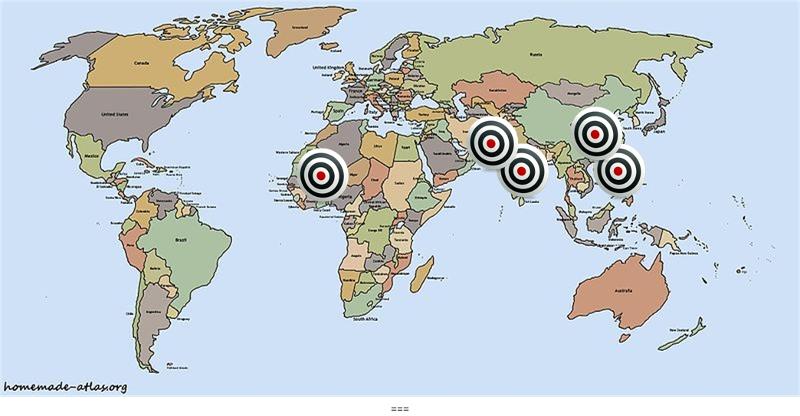
Nina Novus provides an update on the progress she has made.

Directions: Play only one of the following videos to the location that you've identified.
China

Philippines

India

Mali

Pakistan

She picks up an emergency passport, her overnight bag, and her electronics bag. She starts working on her questions list for Dr. Mundi.

Where in the World is Dr. Salus "Dynamica" Mundi?
Refugee Camp Readiness
Nina Novus Scriptor is scanning Twitter, then the Web, for any news of Dr. "Dyna" Mundi. There was one Tweet recently congratulating her on a successful global health event promoting prenatal care, but there has been nothing that might indicate her location. Scriptor opens up her digital file to add some more information about her target.
Dr. Salus "Dynamica" Mundi speaks English, French, Spanish, and snippets of other world languages. She maintains a full raft of inoculations to enable her travels to most parts of the world. She packs her own vitamins to keep up her health when she travels. She apparently maintains several homes on different continents.
Then a snippet of news from the airport. A woman who has been verified as Dr. Mundi has been seen at the local airport. A scan of her bags showed that she packed comfortable shoes including some airy sandals. Her clothing appears light and easy to hand-wash. She has a small bag of various over-the-counter medications—anti-diarrheal pills, mosquito repellant, sunscreen, and a small first aid kit.
Then another Tweet: " "Gani, Dr. M—in the n. hemisphere, working on camp design!" Then another colleague posts an image. The image looks to be an image of many tents scattered along flat ground. The photographic image seems to have been captured with a camera without automated global positioning system (GPS) metadata coordinates captured.
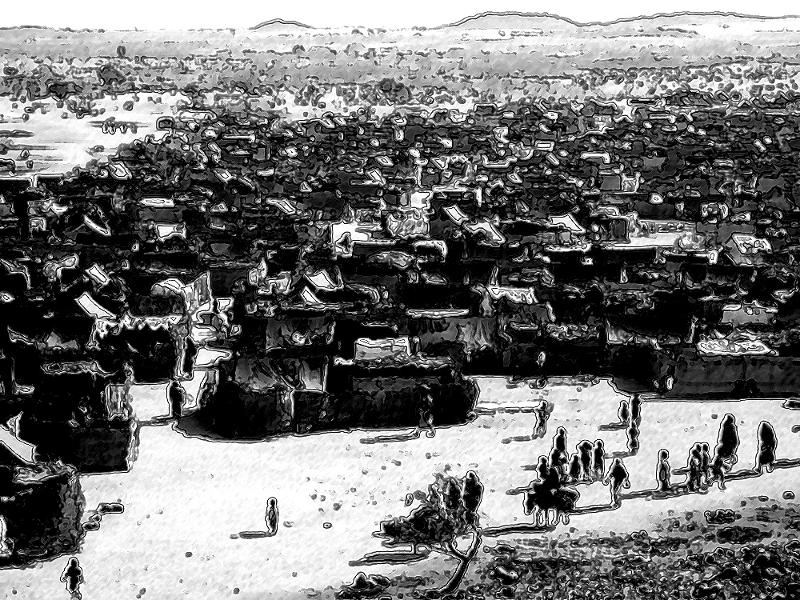
(The above image is an open-source image about a refugee camp. The image was modified to make it somewhat less recognizable.)
Her editor is still interested in the story but cautions her: "The budget on this story is starting to dwindle. Make sure you get the scoop!"
|
A BLOG POST
Understanding Refugee Camps and their Dynamics
By Dr. Salus "Dynamica" Mundi
A refugee camp is generally defined as: "shelter for persons displaced by war or political oppression or for religious beliefs," (Princeton: http://wordnetweb.princeton.edu/perl/webwn?s=refugee%20camp ). Yet there is much more to fully understanding what makes up a refugee camp and its way of life.
Structure and Organization
Most refugee camps are built on the edges of towns or cities, always from risky areas like borders, war zones, or areas with known land mines. These are built near water sources, so that the people can access the necessary water for cooking, drinking, bathing, and clothes washing. The logistics of such refugee camps require access to modes of transportation to receive the various supplies necessary for running such camps.
The residents nearby are often leery of those in the temporary camps because they fear that these newcomers will destabilize the local areas and compete with them for food or water. This is why it is often important to have local government support for such camps in order to enable them to function.
A photo posted of the camp shows acres of canvas tents set up across the dusty and flat ground; some of the housing is make-shift, with any sort of scrounged blankets and tarps used as coverings against the elements. Families crowd around water boiling in pots. Many of the refugees move slowly around the camp. Many look dazed. There is some semblance of order. Some parts of the camp seem more orderly than others. The refugees had already started gathering before international aid organizations arrived to help, so some pre-existing sections seem like a mish-mash of humanity. A field hospital handles those who are in need of acute medical care.
Medical Issues
Those who are seen to have potential diseases are separated out from the others—in a kind of quarantine—to mitigate the risks to others' health. The camp, even though it's been surrounded with fencing or barbed wire to keep out marauders, cannot control for the animals that wander through the camp. There are some of the burrows that were used to bring some of the families to the camp. There are also some stray dogs. Animals may carry zoonotic diseases that affect human health, so the camp physicians pay attention to symptoms of ill health in the animals that may be indicative of possible zoonotic diseases.
Water-borne illnesses are a health risk. Most water sources provide water that is not potable, so it has to be boiled thoroughly or treated with chemicals to eliminate dangerous bacteria, viruses, and other pathogens. Latrines are placed downstream from water sources—so that human waste will not lead to various illnesses like various parasitic infections and diseases ( http://en.wikipedia.org/wiki/Waterborne_diseases ). Refugee camps have used various methods of providing spaces for the collection of human waste—such as collective trench latrines, pit latrines, and defecation fields.
Hygiene is difficult to maintain in the refugee camps. The only laundry services are by hand-washing, and there is not any organized system for that except at the make-shift hospital.
Refugee camp workers have to maintain their own physical, mental, and emotional health and stamina in order to best serve those around them. However, they also need breaks from the crowds in order to build up the strength for themselves.
Published sources define the basic provisions needed for each person: a gallon of water a day, and a daily food ration of 2,261 calories daily. The provisions may consist of rice, wheat, or maize (400 gpp = grams per person); beans, peas, or lentils (60 gpp); vegetable oil or butter oil (25 gpp); fortified blended food such as a corn soya blend (100 gpp); sugar (15 gpp); and salt (5 gpp)—for a total protein intake of 71.2 grams and total fat of 47.9 grams. It is important to get the food to women usually because they tend to disseminate the provisions to the vulnerable members of the community—the elderly and the children. Sometimes, men who receive the provisions will try to sell the items for other uses. There are areas for feeding the starving, with specialized foods designed for those of various ages and for the easiest assimilation into the human body. All the workers at the refugee camps will be working 12 - 15 hour days.
Politics and Administration
Everyone who is in the camp is registered and photographed, in order to maintain some semblance of order. This information will be important also to maintain health records of the camp residents. Such records may indicate particular health needs, which need to be addressed in a timely and effective way. Refugee camps also maintain records of death rates and the causes of death. Common causes of death include measles, diarrhea, acute respiratory infections, malnutrition, and malaria (Anatomy of a refugee camp http://www.cbc.ca/news/background/refugeecamp/) .
This information will be used to enforce the rules of the camp. Peacekeeping forces (or in-country military or police) police the outer rim of the camp; internally, those running the camps use the local police of the host countries within (for those with working governments)—particularly in the larger camps. Good lighting is critical to promote security for the residents of a refugee camp. Those in areas without a functioning government have to bring in international peacekeepers for this work, which further complicates the challenges of running such a camp. Further, this information will be used later to help individuals re-settle. Further, they are inoculated against common diseases—because the crowded conditions enable the mass spread of contagious diseases. The children play a simple game of soccer. The global public health workers do not know how long this camp will be in operation. There is no way to predict how the political wrangling among armed groups will take, and the effects of a drought can be long-term. While refugee camps are meant to be temporary, some have lasted for years (with some topping 50 years in existence). The weather in June in this country is fairly hospital to tent living, but as the weather evolves and turns colder, the camp will have to bring in blankets, warmer clothing, and heat sources.
Most camps also have spaces for group meetings to help the residents self-organize and to empower themselves with activities and endeavors that improve the lives of the residents.
The infrastructure of a country will take years to build or re-build. The government itself has been asking for international aid for more resilient and diversified food crops and help with setting up irrigation systems; they also have asked for international volunteers to train their country's farmers. The international health workers that run the refugee camps learn from every interaction—in order to better address the moves of masses of humanity and their needs—in the inevitable natural and human-made disasters that seem to afflict people. They know the importance of trying to create resilience in all societies against such exigencies. They also know the importance of maintaining strong political relationships with the leaders of various countries. They also work hard to stay neutral in the face of politics, to minimize risks to the health workers who deploy to many areas of the world. The workers strive to fit within the cultural expectations of the locals, so as not to give offense.
|
Nina Novus makes a video update.

It is now June. The latest sighting of Dr. Salus "Dynamica" Mundi has been at a refugee camp ( http://en.wikipedia.org/wiki/Refugee_camp ), the staging area for the sustaining of human lives in turmoil. Nina arrives at the airport and scans the monitors. She knows that Dr. Mundi arrives no more than an hour prior to her flight. She has a list of preferred airlines, on which she is racking up mileage for free flights. Ticking off the list, Nina has five choices of destinations. All five locations have displaced persons who could be at refugee camps. If she wants any chance of catching up to her, she has to get on the next flight out. She has her colleagues paying close attention to the various information feeds and a Google Alert on Dr. Mundi's name. If her paper is going to get the world exclusive on Dr. Mundi, she's going to need all the help she can get.
She grabs her trusty suitcase with the easy-wash clothing. She packs granola bars, tuna, and water. She has her international press pass. She brings her backpack with the necessary technologies--her spendy satellite telephone, a digital camera, and her tablet PC.
She peruses a map of the world.

Directions: Play only one of the following videos to the location that you've identified.
Ecuador

Japan

Kenya

Canada

Ethiopia

She applies for an emergency entry stamp for her passport and buys round-trip tickets. She packs a bag with some basics. She boards the plane. When it gets to altitude, she turns on her tablet PC and starts drafting up questions--for when she finally meets up with Dr. Mundi.

Where in the World is Dr. Salus "Dynamica" Mundi?
A Diagnostic Lab

Nina Novus is watching the lab workers from a distance and through a reinforced glass window. Her editor has sent her to a local BSL-2 (biosecurity level 2) laboratory to see some of the barriers put into place for the testing of pathogenic (disease-causing) agents. The biocontainment facility involves a number of features which surprise her. She is surprised to hear that spills occur fairly regularly, and what passes for a spill may occur simply because a person walked behind a researcher working in front of the chemical fume hood. She has read in depth about how scientists and researchers have to gear up with great caution and then reverse the process and shower out in higher levels of biosecurity containment (with a scale that runs from 1 - 4, with 4 as the highest biosecurity level for highly contagious and dangerously pathogenic germs).
Novus commits everything she sees to memory. Her BSL-2 laboratory guide told her that it's critical to run scientific tests to verify what agent caused a likely illness before any decisions are made in autopsies or in even more complex scenarios, such as potential epidemics. Those who work in such labs go through a wide range of training. They seem highly aware of every move they make to avoid any sort of contamination or spill. They seem resigned to their slowness of movement and methodical steps. Their work is multiplied by various technologies, though, that enable them to test a number of samples at once.
And because of the privacy policies around human health issues, human samples are marked with electronic 2D codes in order to capture and collate health information but only for those who have a right to access that information—such as individual doctors and their patients. She is getting a systems view of the processes. Her lab guide mentions the criticality of the "chain of custody" of the samples, so it's clear where and how the samples were taken, who legally handled the sample, and so on—to make sure that no sample is tainted en route for confusing or inaccurate results. Nina has visited this facility to get a hands-on sense of what such a laboratory looks like.
Rumor has it that Dr. Salus "Dynamica" Mundi is headed to a diagnostic laboratory to vet their procedures and to also get a sense of some of the new technologies and techniques used in such spaces. Others say that she is going to a christening of a space. Some of the more far-fetched claims on the Internet are that she has a very high-value sample that cannot be sent by courier, but Dr. Mundi has not worked in such labs for years—according to her official biography—and she likely would not be handling such high-risk samples in her travels. There are many laws against the transport of biohazards, including highly pathogenic agents, which have to be handled in very particular ways so as to head off the potential spreading of diseases and the corrupting of samples.
On YouTube™, there is a video.

Given Dr. Mundi's most recent travels, she is probably pursuing the latest outbreak of a virulent form of zoonotic influenza. The fact checkers at the news agency suggest a shortened list of BSL-3 laboratories in the world specializing in such cutting-edge high-risk research are in particular countries. This is the best they can do from the lists of dozens of such laboratories all around the world.
As Dr. Mundi was going through the TSA line at the airport, she was seen on camera to have a badge to a BSL-3 laboratory. Based on her time and location at the airport, there were only five flights out to the various locales of the BSL-3 (and BSL-4) laboratories. Nina Novus peruses the map.
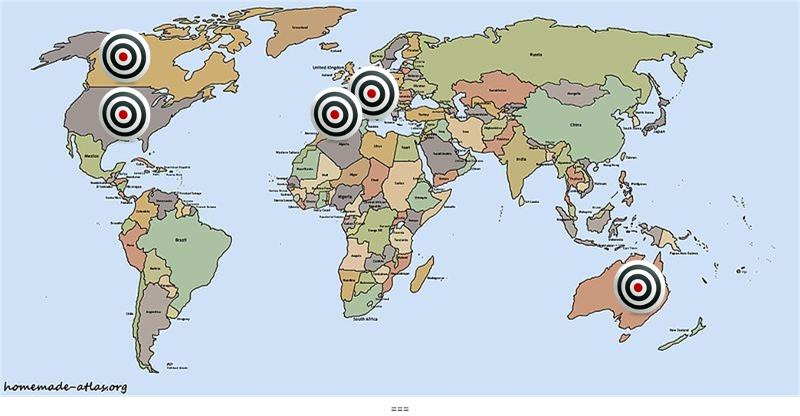
Nina Novus makes a video update.

Directions: Play only one of the following videos to the location that you've identified.
Germany

France

USA

Canada

Australia

Dr. Salus "Dynamica" Mundi: Traveling around the World for Global Public Health
Nina Novus has finally caught up with Dr. Salus "Dynamica Mundi! Click on the image below to view their videotaped interview.
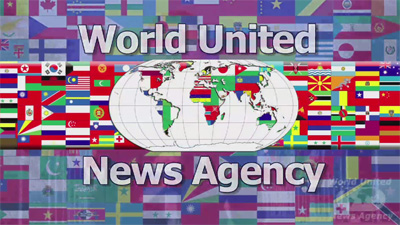
Transcript (.docx)
Transcript (.pdf)
The Brief Global Health Backstory of the Game
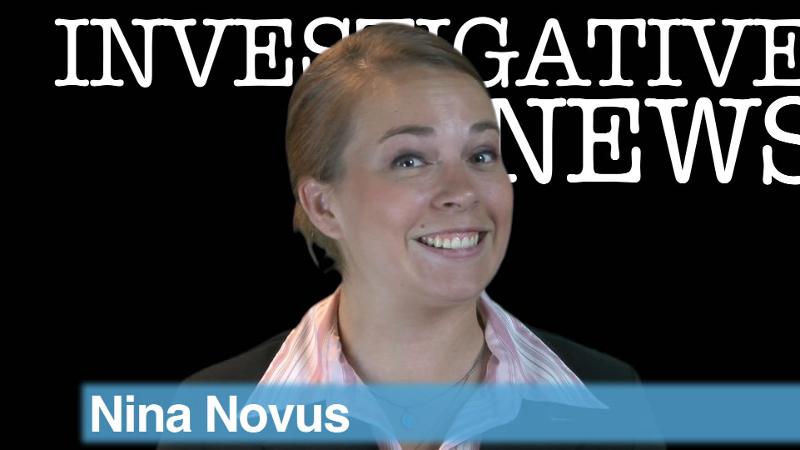
(Mary Werick as Nina Novus Scriptor, intrepid reporter...)
Early Game Design Thoughts
The heavy-travel involved in the work of a global public health practitioner served as a core inspiration for the "Where in the World is Dr. Salus "Dynamica" Mundi?" game, which was built to focus on the interconnected and global nature of international public health. While information and communications technologies (ICT) are integrated and so critical to global public health, so much of the work has to be done person-to-person and in an on-ground location-based way. The play would be true to the medical science and culture as much as possible. The global aspects of this course lent itself to the idea of a geographically based game--as a structure on which to hang the ideas. The actual play would be light. The focus would be on making the game as accessible as possible to as wide an audience as possible. The game is not part of the global health course; rather, this is a value-added add-on as a culmination of the course design.
Other alternative structures? Certainly, there may be other ways to frame a game. There may be an unfolding scenario of an unknown disease unfolding. There may be a natural disaster and its aftermath. There may be a detailed preparation for a team going into a particular village with various needs. There may be a purely science-based adventure in a laboratory with an unknown pathogen with a pathogen hunter. The possibilities are numerous. As with most design situations, we went with what we could achieve given the budget, time, technology, and other limits.
Awareness of real-world sensitivities. Then, given the political sensitivities of various potential depictions, it was decided that separating the fictional game from the real-time exploits of the principal investigator (PI) and professor of the Global Health course would be critical to the success of the course, the game, and the continuing professional work of Dr. Deborah J. Briggs. There would be a conscious avoidance to separate the fictional game reality from the real-world one. The science, though, should be accurate, so there is no accidental "negative learning" (inaccurate, unintended learning) from the playing of the game. We would emphasize this point with a disclaimer—not to be legalistic but rather to not accidentally impugn anyone with the storylines. This "backstory" piece is a kind of debriefing of the game history.
Takeaway Concepts
While the team decided not to use real-world cases with a fictional character, they realized that it would be critical to highlight some basic tenets of global public health. These themes would infuse the mystery cases, and they would add some pedagogical value to the game. These concepts were drafted out in the early documents of the game design to serve as guiding principles.
- First, do no harm. A lot of care goes into global health to make sure that endeavors undertaken are health-promoting, sensitive to local cultures and ideas, and optimally, sustainable. Endeavors may have intended and unintended consequences, and much analysis goes into such potential effects.
- Complex environmental factors. The public health interventions are designed to deal with complex situations, with public health affected by economics, politics, culture, science, human behaviors, and a range of other factors.
- Strategic partnering: The complexity of global public health may be seen in part by the various partnerships involved. Global public health is a community affair. Various partners include governments, non-governmental organizations, people groups, pharmaceutical companies, insurance companies, health care workers, epidemiologists, food scientists, law enforcement, and others. These various stakeholders all have critical roles to play. In this highly competitive field, there may be various types of personality strife. The nemesis has to be poverty and diseases, never other people.
- Public education and training. At one level, public health involves individual decisions made at the ground. Decisions made that become habits can affect overall health of the individual—such as decisions to consume alcohol, illicit drugs, high-fat and high-caloric foods, and to smoke cigarettes. There are certain modes of disease transmission that will be important for people to know to head off potential pandemics. The public has to be informed and empowered at the local levels to make the choices that will benefit their own lives. It would be important to show the importance of education and training to get a population engaged. It is also important to show the need for near-continuous learning by the global public health individual. It would be important to get information about working with different people groups in a respectful way.
- Global surveillance and early notification: Global public health requires early notification of emergent diseases and of potential pandemics—through accurate global surveillance, rigorous lab testing, and epidemiological work. Early information will allow for expert consultations and whole response packages. It will enable a rallying of the global health networks (both formal and informal) to rally a response that may head-off the potential spread of dangerous pathogens.
- Concept of baseline health and resilience: The concept of having basic health (appropriate nutrition, maternal care, early childhood nutrition and care, sanitation and hygiene systems, strong governance, and appropriate educational systems) and basic public health structures and communications systems in place strengthen the resilience of a society against health challenges—whether these challenges are naturally occurring or human-made or a combination of those causal factors. There needs to be expertise in the community to ensure that the proper help comes at the right time. There are definitely "one health" issues at play. The needs of animals are also important for overall health because of zoonotic diseases. Global public health involves creating expansions of capacities and functions.
- Sustainable critical Infrastructures: The focus on national security in the US has led to a definition of critical infrastructures and global manufacturing chains that affect public health. It would help to show how these take years to design and build over time. These are often a result of smart planning and the overall resources and leadership of a society. Whatever global public health structures are put into place have to be sustainable into the long term.
- Basic health science: It helps to look at the scientific underpinnings of public health. Some assumptions of public health involve understandings of disease and disease transmission. There are a number of dependencies in the understandings of what leads to public health.
- Technological surveillance and interventions: Information and communication technology (ICT) inform and affect global public health. It will be important to bring in data-rich approaches. Further, the game characters should all be wired in and wired up, to encourage the uses of various public health ICT resources and technologies.
Creating a mystery. The game had to be an automated one because that would make it easier to deliver and more scalable. Another design option was to potentially add an interactive discussion element, such as a Twitter feed or a wiki that participants could contribute to. Given the lack of general audience knowledge of global public health, it seemed that a mystery based on geography might be more doable than any sort of a science-based medical mystery. We were using the framework of a game to inspire readers—not to test their global public health knowledge per se.The plan was to have the global health heroine leave clues with electronic snippets of information, with her packing, with her foreign exchange currency, her transportation, the localized health issues, and other information. This game concept borrowed lightly from a popular game that was turned into a television series that focused on the learning of geography.
Essentially, each game scenario would consist of a basic fictional case (using text and multimedia), a video with clues, a map with the question of where the doctor could be, and then decision-making—with results. There would be a debriefing summary at the end with possibly some light teaching points about global public health. These scenarios would be strung together with clues from one case to the next. In the intermittent locations, if caught up with, the doctor would offer some clue. There might be a "reward" of seeing the doctor in a particular situation or in particular local garb. All the locations where she is found will be different from each other. Ultimately, the elusive doctor would be caught up with and would share some profound information about global public health.
The limits of the technology coding. In any technology-based build, the development team works against the limits of the technologies and their own imaginations. For our situation, we had limited authoring tool technologies to achieve any sort of simulations—so the game itself could only be evoked with a limited set of interactions and details. The green screen chroma key aspect of videography was brought into play in order to be able to use a video snippet of the elusive doctor again and again—with different background images of various locales from around the world. While there was access to some original raw materials, we would mostly have to use open-source contents and whatever our minds could afford. Some of the technologies considered have been integrated here. The development team also wanted this all to be mobile accessible, which would mean limited uses of Flash technologies.
Character ideas.The development team struggled to find a name for their main character without using anything that already existed in the world. They decided to go with a Latinate underpinning, and they came up with Dr. Salus "Dynamica" Mundi (Dr. Health Dynamic World). This name would indicate her role but would also show how health links with the dynamism of a life. People who suffer various diseases experience devastating effects on their livelihoods, with many unable to earn a sufficient living because of health challenges. In her work travels, she would model safe and healthy travel, with respect for those with whom she comes into contact. The elusive global health doctor would be chased by a young reporter, Nina "Novus" Scriptor (aka Nina the New Writer). (For those who care, a variety of names were considered for the doctor. The English versions sounded cornier than the Latin forms: Dr. Infirmorum Liber, Dr. Sapientia Sanitas, Dr. Morbi Exstirpatione, Dr. Morbo Liber, and Dr. Salutem. The reporter's family name could have been any of the following: Testimonium, Testis; Discipulus, Alumno; and Secuutus.)
Game scalability. The game is a kind of automated learning. There is no human oversight to the play. The gameplay is not tracked. The playability then depends on the server load of all individuals accessing the game at a particular time.
The resources used for building the game. The game drew heavily on extant resources provided foremost by the subject matter expert (SME), Dr. Deborah J. Briggs. It also drew from the curriculum and the work done to achieve understandings, to set up a diversity of scenarios.
Assessing the game. This game was created to help general readers access some of the basic concepts of global public health. There is not a formal assessment currently to test some of the learning in the game. If one were to be created, it would draw on the main global health principles here.
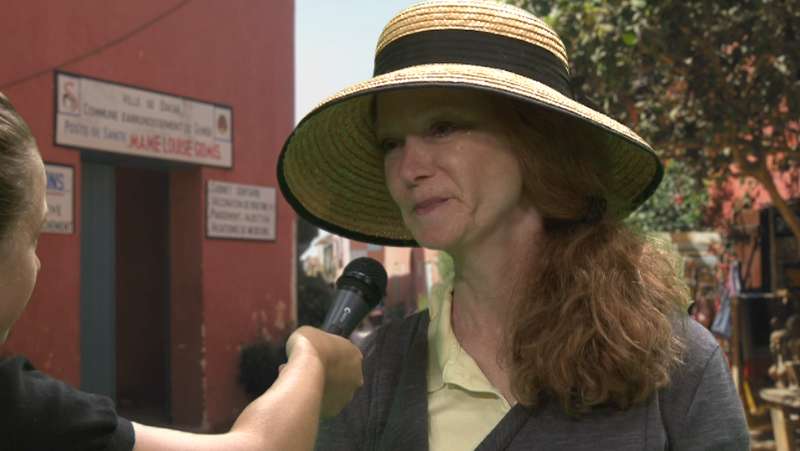
(Dr. Deborah J. Briggs as Dr. Salus 'Dynamica' Mundi...)
The Game: Goals, Creation, and Assessment
A Case Study Explanation of the "Where in the World is Dr. Salus 'Dynamica' Mundi" Higher Education Game
By Brent A. Anders
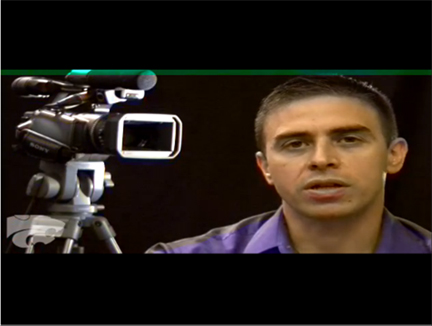
(Brent A. Anders discussing the Videography Work for the Game)
 (A downloadable version)
(A downloadable version)
GOALS
To begin with, this was a difficult but rewarding task in that our goal was to help students learn about what it is like to be part of the world of Global Health. This was our main goal, but we had many sub-goals as well.
We wanted to accomplish our main goal through means that would motivate students and peak their interests in the subject. It needed to be accomplished separate from the main course and had to be stand alone, not requiring constant instructor assistance. Additionally it had to fulfill a very important technical request in that it had to be "cool/fun," and use/showcase current modern technologies. Through the medium of a higher educational game, the goals of this project were attained.
CREATION
Starting Blocks:
The initial creation of the game was the hardest part in that it was difficult to see the big picture as to what the game's function was to be. It is very important for an instructional designer and an instructor to fully address the purpose and function of the game. Here are two very important questions to fully address:
After playing this game, my students will: _____________________?
This is important to my students because: ____________________?
In the case of this higher education game "Where in the World is Dr. Salus 'Dynamica' Mundi," the answers are as follows:
After playing this game, my students will:
Have a better understanding and appreciation for the many different areas and aspects of Global Health. Realize the interconnectedness of issues and areas associated with the topic of Global Health.
This is important to my students because:
In understanding and appreciating the interconnectedness and aspects of Global Health, the information within the course will be that much more impactful, relevant, and applicable. The game itself will be fun and motivating which will transfer to the actual course.
Game Play:
The next part to address in games creation was on deciding what type of game this was actually going to be. There were basically two game-modalities to choose from:
The first is that of a type of game where the user learns directly from the game and applies this knowledge/skill to complete/continue on with the game (lets call it a "Direct Learning Game"). The older game "Oregon Trail" is a great example of this in that you directly learned what it took to survive on the Oregon Trail and then you applied that knowledge/skill so as to continue on and finish the game. Another example would be a first person shooter games in that you improve your ability to shoot as well as start to learn how to maneuver and find your way through the game's map. The game directly teaches you this information (or skill) and then you use this information to win/succeed.
The second type of game is one where the learning content is presented but isn't necessarily the main focus of the game (let's call this an "Indirect Learning Game"). Here learning content is shown/mentioned within the game but not specifically taught. An example of this could be a simple racing game where the game takes place across all 19 states/territories that make up the Middle East (reference: CIA Factbook). Students would be given various cues (audio/visual) that they were now racing in a particular Middle Eastern country, within its capital: "You are now racing in Doha, Qatar!" The game objective would be to win the race but the indirect learning would be for them to learn the location and names of the Middle Eastern countries and their capitals. Benefits to this type of game are that it is much easier to create. One would take an existing game and simply apply scenarios, locations, etc. that correlate to the desired subject matter. Another benefit is that one can apply it to a popular game that has been tested and people are already motivated to play (racing type games continue to be vary popular across all gaming platforms: cellphones, laptops, Xbox, PlayStation, Wii, etc.).
The decision was made that Global Health would have an indirect learning game in that it best correlated with the previously stated goals.
The "Where in the World is___" type of game is actually a "Choose Your Own Adventure" type of game. You are given information and then you choose a course of action (where to go or what to do). Depending on how the information is presented within the game. For our game specifically, the game consists of being presented with a Global Health situation in which the main character's (Dr. Mundi's) actions are described. The viewer (student game player) views the information and tries to identify clues as to where in the world Dr. Salus "Dynamica" Mundi could be. They then choose where to go. While identifying clues and deciding where the Doctor could be they are being exposed to issues dealing with global health and its interconnectedness, which equals indirect learning.
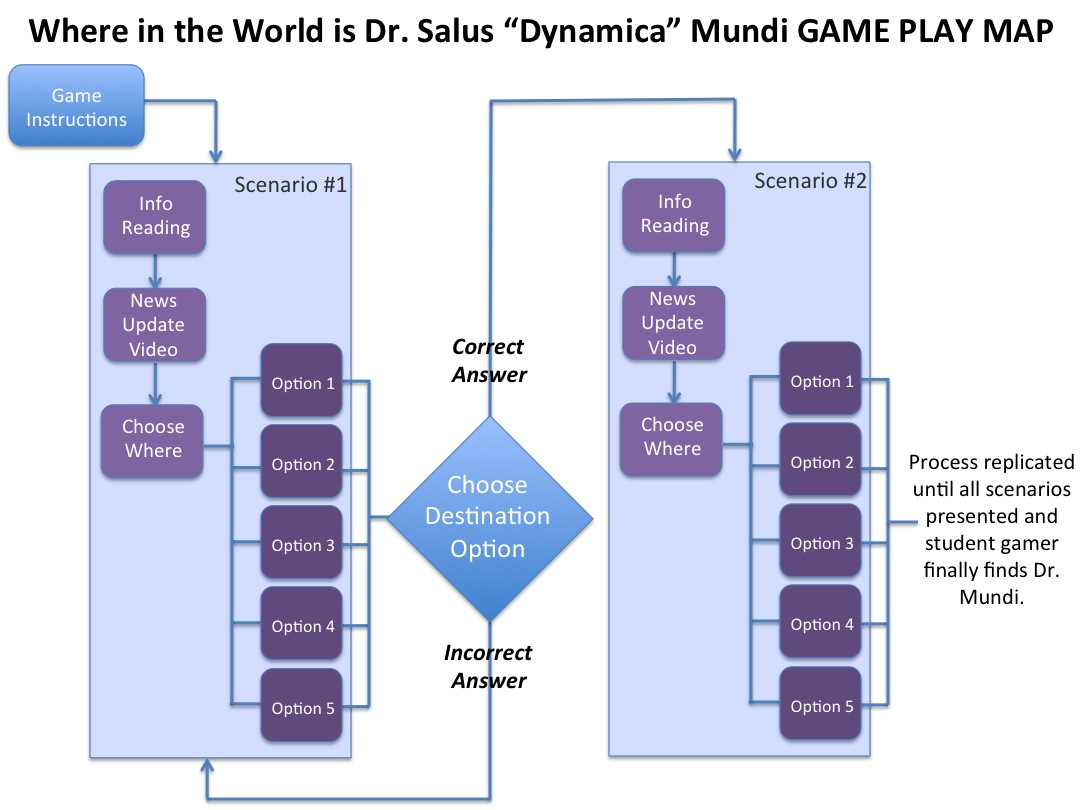
The game is self-correcting in that a wrong answer will take you to a location where the doctor is not present, but you will simply be allowed to choose again until the correct decision is made. This is beneficial in that it does not require the instructor to be constantly present or monitor the students' game play. The function of the instructor is to teach the course and answer questions, not to administer the game.
Game Style
Many different techniques where contemplated as to how the game would actually be presented. Some of the delivery ideas included iPhone/iPad app and Flash. Although they still haven't been completely ruled out, the choice was made to use regular web pages with videos. To stay with the theme of global health and to maximize excitement and motivation the game needed to take place within many different countries. Since the budget did not contain millions of dollars for on-location filming, the use of green screen was incorporated. Actors where filmed in front of a green screen and where then digitally placed in scenes such as on an airplane, in Canada, India, Sweden, Russia, etc. Use of student actors and volunteers as well as domain-free images were used to keep costs down. The positive results greatly enhance the game's realism and emotional impact so as to aid in learning.
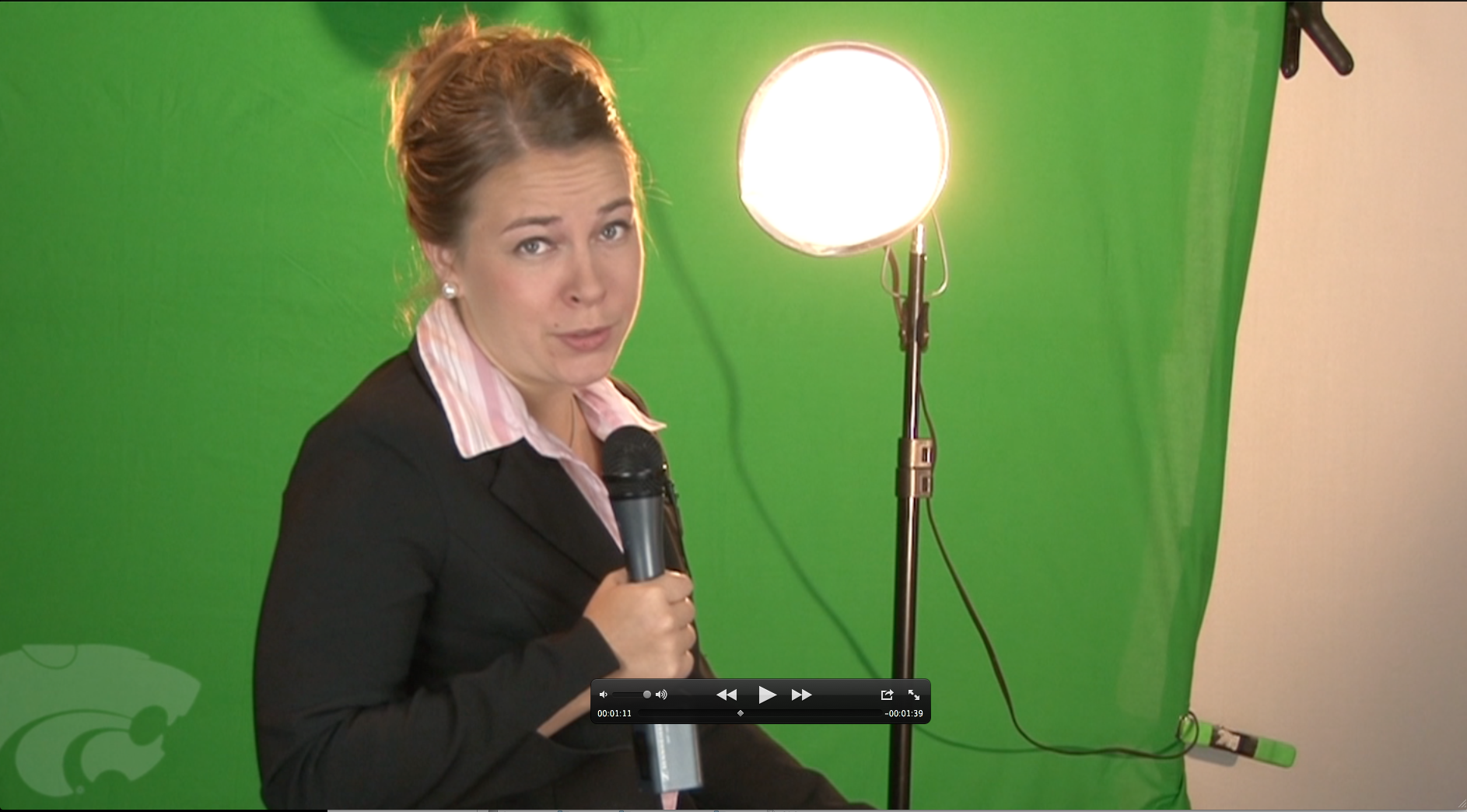
(Green Screen Still of Actress Mary Werick)
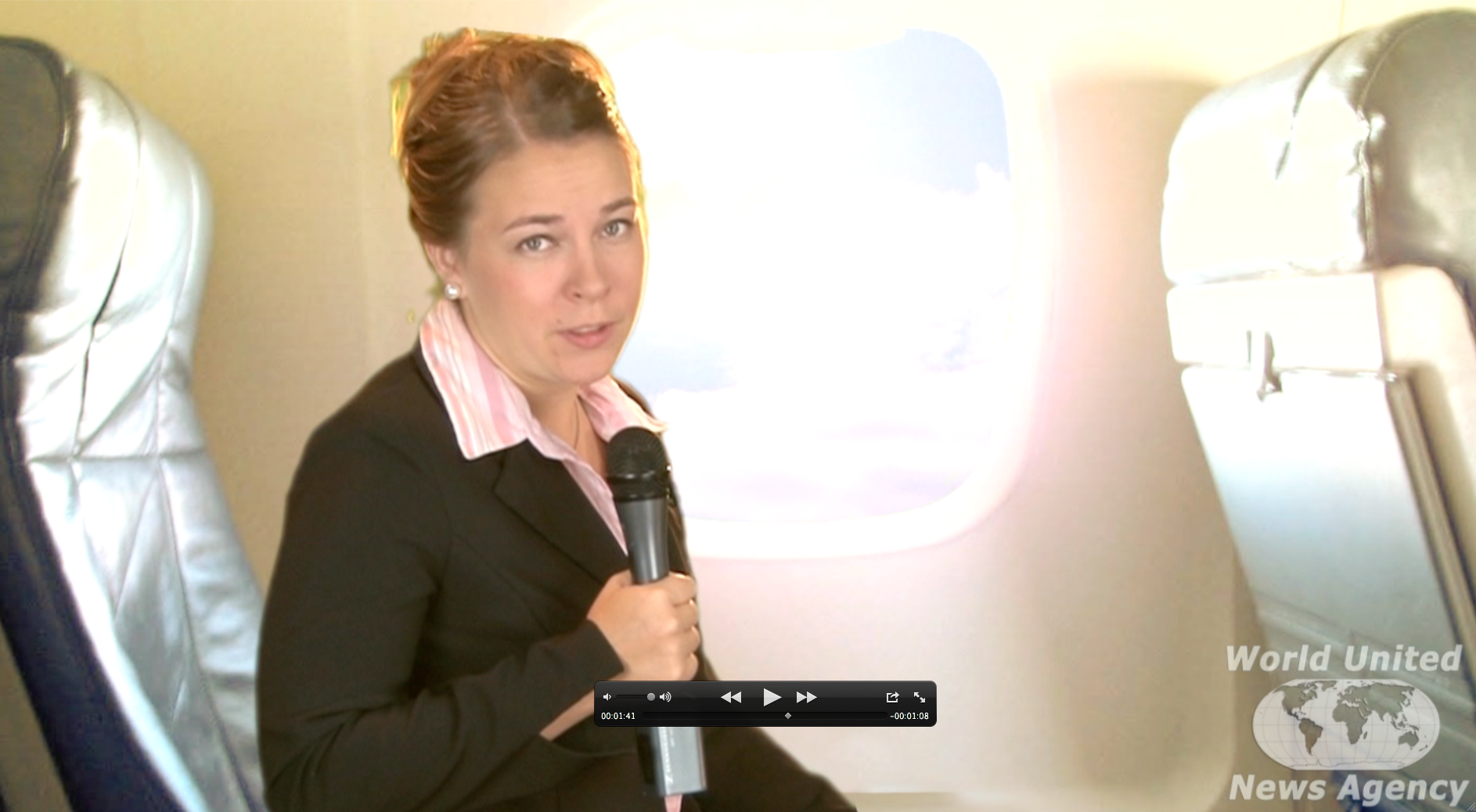
(Digitally Edited Video Still of Actress Mary Werick on a Plane)
The idea of following a global reporter was used so that she could talk directly to the student gamer so as make the game more personable and impactful. The reporter assisted with the clues presentation and allowed the student gamer to be exposed to multiple technologies/media types such as: web magazines, YouTube Videos, Facebook, LinkedIn posts, Twitter, and others. This was beneficial in that it was one of the main goals set at the beginning of the project: be "cool/fun," and use/showcase current modern technologies.
Game Costs
The charge for the video and script work done for this video was $3000, but a lot of it was done via volunteer work and people simply donating their own time and effort. In actual work hours, the total would be about 80 to 100 hours (this could triple the actual cost of creating the game). But the costs can vary based off of how one would chose to make and present a game, whether one chooses professional video or not, or if video is even used within the game. The only limitation is in one's own creativity.
ASSESSMENT
Assessment is always an important aspect of any project. As this project has yet to be fully implemented, only minimal assessments have been done. These have consisted of presenting the game to higher education students and judging their reactions to it. So far it has been vary favorable.
Various means where considered for the assessment component of this game. One idea was to create a "game score" so that students would gain points for getting correct answers and lose points for incorrect answers. This idea didn't correlate well with the goals of the game so the current plan of assessment is to give surveys to the students so as to ask their opinions as to the value of the game. An optional idea would be to teach the class to two separate sets of students, one with the game available and one without the game available and compare student grades. It would be difficult to fully compare classes in that the game is to be presented as an optional tool. Students will not be forced to play the game, it will just be suggested by the instructor as a way to better understand and feel what it is like to be a global health practitioner.
CONCLUSION
Although there are time and monetary costs, creating a higher education is worth it. Further assessment are of course needed just as in any venture into education but make educational content more engaging and fun is needed across virtually all areas and games are one way to make it happen. This project was hard but fun while at the same time causing deeper thought of the subject matter and motivation to continue to improve.
Onwards... and Contact Information
The development team's learning from this game continues based on feedback from those who've played and chosen to share comments. Please feel free to contact us via email.
Brent A. Anders (superman@k-state.edu), Director, Videographer, and Game Master / Game Script Writer
Dr. Deborah J. Briggs (briggs@vet.k-state.edu), Principal Investigator, Writer, and Game Inspiration
Dr. Shalin Hai-Jew (shalin@k-state.edu), Instructional Designer, Writer, and Instigator
Zachary J. Caby (zjcaby@k-state.edu), Videographer and Actor
Mary Werick (mkwerick@k-state.edu), Videographer and Actor

Acknowledgments and Thanks
The Principal: Dr. Deborah J. Briggs is a dream to work with. She is informed, supportive, thorough, conscientious, and easy-going. She is game to try new things, and she took risks in ways that many faculty would not. She allowed us to play off the reality of her near-constant travels as the core inspiration for this game in order to share her knowledge of global public health and rabies prevention. That Dr. Briggs does not earn a salary for her work says a lot about her personal commitment to global public health.
The Actors: Thanks to Dr. Deborah J. Briggs, Zachary J. Caby, Mary Werick, Dr. Jodi Freifeld, and Artur Gregorian, for their cameos in the game videos.
Funding and Administrative Support: The K-State College of Veterinary Medicine paid for the videography work for the game, which was provided through the Office of Mediated Education. The Information Technology Assistance Center (iTAC) provided instructional design support under a grant for the co-development of the graduate course; it contributed the work for this article, photo album design, and game work gratis. K-State's Division of Continuing Education covered the seed money for creating the course on Global Health. The development team is grateful for the support of the administration.
Support from Others: SoftChalk CONNECT has generously provided a free account for use by the development team to present the sidebar on rabies prevention and this game, into perpetuity. Thanks to Steve Saltzberg for his help in arranging that. The Vimeo® video sharing service was used to host some of the videos. The development team is grateful for that free service.

















